|
Messerschmitt
Bf 109G-10
by
Stéphane Wrobel
|
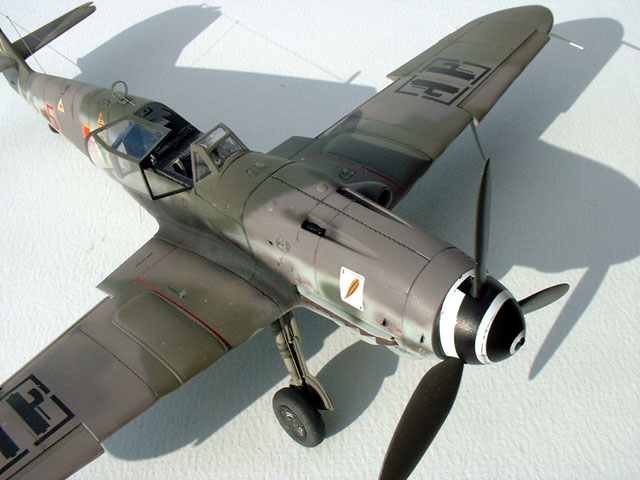
|
|
Messerschmitt
Bf 109G-10
|

Hasegawa's
1/48 scale Messerschmitt Bf 109G-10 is available online from Squadron.com
This is the Hasegawa 1/48 Messerschmitt B f109G-10. Most of the
" 109 lovers " know what is nice and what's wrong on this
kit.
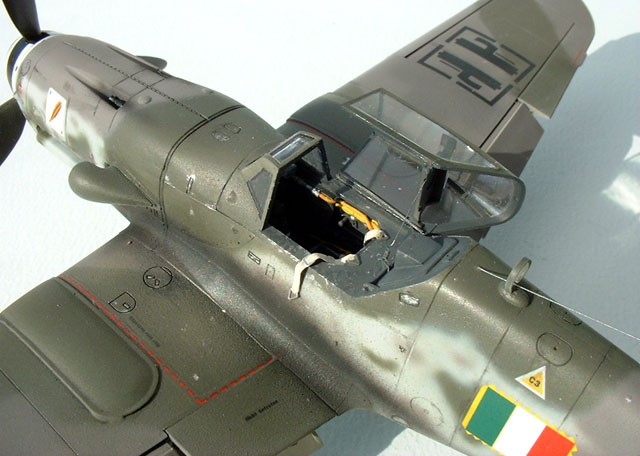
The biggest change has been the addition of the Adeco cockpit set
and some scratchbuilt details.
This kit is very nice, maybe even nicer than the earlier Hasegawa
Bf 109K-4. The engraved detail is very well done. A minimum of putty
is required, mostly on the lower surface, between the wing and the
fuselage.
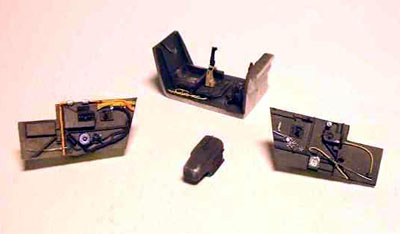 Adeco's
cockpit is a jewel, very easy to built in and the instruction sheet
gives you all the painting details which is pleasing considering many
resin manufacturer often forget to do so. Adeco's
cockpit is a jewel, very easy to built in and the instruction sheet
gives you all the painting details which is pleasing considering many
resin manufacturer often forget to do so.
Most of my scratchbuilding efforts were expended on the wheel well,
which needs to be redesigned ; and around the rear cockpit plate which
is terribly undetailed. The battery box behind the pilot's seat comes
from the original co-axial MG151/20 cover box provided by Hasegawa.
Adeco replace it in their set.
As usual, I've added brake lines to the landing gear, using two
diameter of wire like on the real aircraft. I used Ultracast exhaust
pipes which are marvelous. The propeller blades and the external fuel
tank rack come from the Fujimi K4 kit (this one will be used in the
spare parts box). Fujimi supplied he rudder too, as I've trashed the
original one when I wanted to cut it from the tail.
Click the thumbnails
below to see larger construction pictures:




Antenna wires were made from streched sprue and the Morane antenna
was replaced by a thinner one in plastic. By the way, you should use
very strong glue for the Morane antenna and the ailerons'
couterbalance weight. I spent a lot of time on my knees looking for
them on the ground of my " office ".
First, the whole model was preshaded in black. By the time I
started to paint, I had a lot of airbrush compressor problems. I am
cursed with a frequently faulty compressor ! I had to repaint this
model completely twice. It's certainly the most painful paint job I've
ever done.
The camouflage paints come from Gunze range. Specifically, they are
RLM76 for the underside and RLM75 and RLM83 for the upper surfaces.
Note that this aircraft has a wooden tall tail which was painted
before the final assembly of the plane by the subcontractor. It is
therefore common to see some variations in shade and pattern.
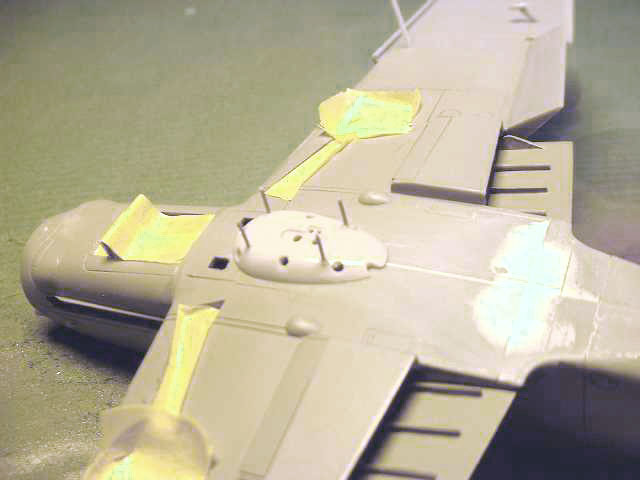
I wanted to depict an Italian G10, an aircraft from the ANR. My
main reference was the marvelous book from F. D'Amico and Valentini on
the Italian Bf109. At the end of this book there is a list of
available aircraft with the type and the werknummer (serial number)
and the aircraft code. I had several choice but most of Italian G10
are known as G10/AS, ie without under cowling bulges and with a square
extension panel on the left side, rather than a curved one.
I asked Ferdinando D'Amico whether a picture of this aircraft had
ever been available and he told me that none have been found yet. I
have therefore completed my scheme based on what I guessed it should
have been.
The decals come mostly from the Aeromaster decal sheet 48-007, an
old decal sheet dedicated to Italian 109 (with some errors inside as
some data in this domain braught new informations) and for the
aircraft code (1-5). I used the Sky Models decal sheet dedicated to
Italian 109 too for the " 1-" and a " 5 " number
coming from a sheet dedicated to the Regianne Re2000/2001 fighter.
Following decal applications, the model was sprayed with a coat of
Aeromaster flat coat followed by a pure coat of gloss coat which gives
a slightly satin finish to the model.
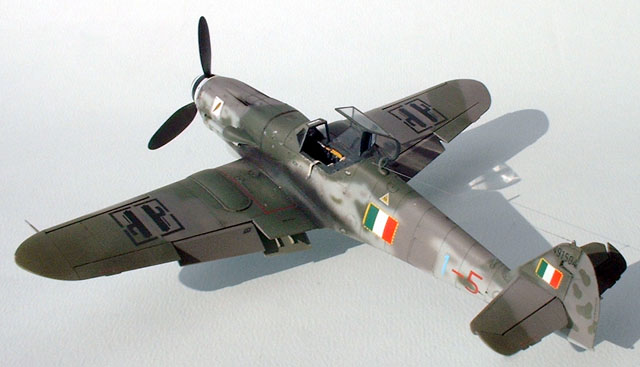
Ferdinando made some more comments when the model was finished, and
I guess I should have asked him more before starting the painting and
markings ! Here are some comment which you can use if ever you want to
make such an aircraft. The Asso di Bastoni insigna wasn't painted on
the right nose side. If ever I feel courageous enough, one day I'll
remove it. On late war Bf109G10 and K4, the underside crosses were
certainlly rather completely black rather than black and white. Last
but not the least, the ANR fasces may had more stencil breaks on the
square by the end of the war, ie two in each corner rather than the
sole break on each side.
For a long time I wanted to build a late war Italian Bf109 and this
project was a good opportunity to do so. I know that this model is not
100% perfect but the result is to me quite nice and it was a good
test bed for several techniques. More Italian 109 are to come,
including an F4, a G2, a G6/R6, a G6/U2, a G14, a G14/AS and a K4. As
you can see, I'm quite busy for several months, considering that among
those there are some Finnish project and other Italian aircrafts such
as a Macchi 205 that I have already started!
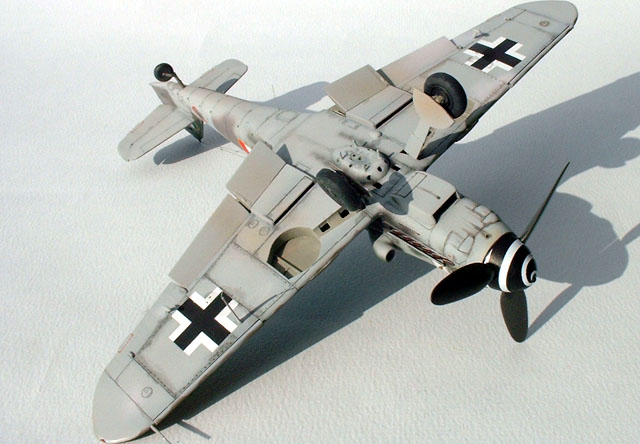
Be aware that if you wish to build an ANR 109, you should dive into
document research. It's a pity that only German 109 are very well
covered. Books such as the D'Amico / Valentini books should be
published more often.
I want to personnaly thanks Vincent Kermorgant for his great
knowledge of the aircraft and Ferdinando D'Amico for his great
knowledge of the Italian Bf109. Both have provided the most
interesting information concerning the aircraft itself and the paint
scheme.
Click the thumbnails
below to view the images full-sized.
Use your browser's back arrow to return to this page.



Model, Images and Text Copyright © 2001 by
Stéphane Wrobel
Page Created 19 June, 2001
Last Updated 04 June, 2007
Back to HyperScale Main
Page
Back to Features
Index
|
Home
| What's New |
Features |
Gallery |
Reviews |
Reference |
Forum |
Search